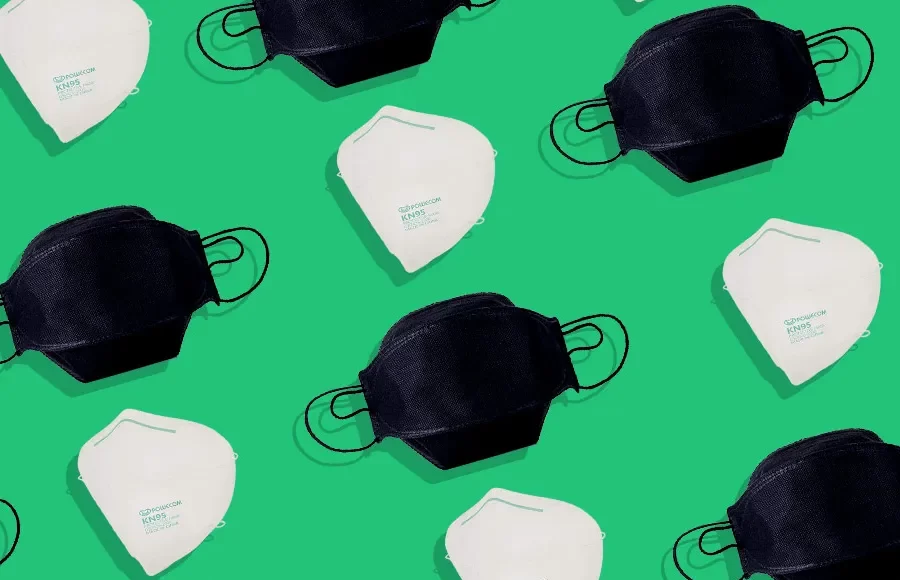Keeping track of which masks we should wear to protect ourselves and the people around us from COVID-19 is a dizzying task, especially now that the Omicron variant is spreading quickly throughout the United States. Earlier in the pandemic, when N95 masks were in short supply and recommended only for medical professionals, more and more people turned to two other popular mask types, KN95 and KF94, since they both come very close to the level of filtration found in an N95 mask. With the new variant on the rise, people are again seeking out these expert-approved face masks. But what’s the difference between the two? And which one is better?
The “KF” in KF94 stands for “Korean filter,” and the “94” indicates a 94 percent filtration efficacy. “It is the South Korean equivalent to the N95 mask, with a few differences. It combines elements of an N95 mask with those of a cloth mask, contouring close to the face with an adjustable band around the bridge of the nose.” Many people like them because the tentlike shape creates a little pocket of extra space between your mouth and the mask.
KN95 masks, however, look more like a bird’s beak and stick out farther off the face. They are considered the Chinese equivalent to N95 masks and are made of the same synthetic material and [also] filter out and capture 95 percent of particles in the air.
You might assume that, because of the one percent difference in efficacy rates, KN95 masks do a better job. But “there are no head-to-head trials [between the two],” says Dr. Aaron Glatt, chief of infectious diseases and hospital epidemiologist at Mount Sinai South Nassau. He says what matters more is how tightly each mask fits your particular face shape and size. “The critical factor for these masks is the face seal. Without a good seal, they are almost all the same, since air will just go out (and come in) through the open spaces on the sides of the mask.” Because of this, Kullar says KN95s and KF94s are more effective when worn by adults rather than children — even if kids are wearing the appropriate size. That’s because children are much more likely to touch their masks a lot, a habit that breaks the all important seal around the nose and mouth.
That said, as the highly contagious Omicron spreads, experts say some of the masks that got us through the early part of the pandemic might not offer enough protection. Dr. Purvi Parikh, an immunologist with NYU Langone Health, says that we should all put aside fabric masks in favor of those that offer higher filtration like KN95s, KF94s, and N95s, regardless of vaccination status. “This variant is very contagious even in vaccinated individuals,” she says. Among the options, Glatt says that three-ply surgical masks are “probably fine,” but that the “KF94 or KN95 [are] theoretically better, if the seal is good.” His preference, if he were to choose between the two, would be to take “the one that fits his face best and make sure it’s not a knockoff.”
To check if your mask provides a tight seal, put it on and look at yourself in the mirror. You should not be able to see any gaps around your nose, cheeks, or under your chin. If the ear loops are too big, you can tighten them by tying knots or adding toggles or a strap that connects the loops behind your neck. To help you predict which one might fit your face best we tested both types. Here’s what we found.
With omicron cases surging, some are shifting from using cloth masks to N95 and KN5 masks for better protection.
These masks are higher quality but there are already counterfeit masks flooding the market and even the CDC warns that about 60% of KN95 masks in the US are fake.
That’s why officials say you have to pay close attention to various labels for these masks.
Here’s a rundown of what we know about these masks. WHAT’S THE DIFFERENCE BETWEEN N95 AND KN95 MASKS? N95 and KN95 masks are quite similar in filtering non-oil-based particles, such as viruses, according to 3M, a multinational company that manufactures and sells a wide range of products, including N95 respirators. The two masks have the same filter performance of 95% or more. This means they both can reduce the concentration of airborne particles that pass through the filter at the same rate. The main difference between the two is where they are certified. N95 masks are approved by the National Institute for Occupational Safety and Health and meet U.S. standards.
CAN I REUSE MY N95 OR KN95 MASKS? Although they are designed for single-use, the general public can wear them a few times before tossing them, according to experts in a Bee report. You can find more information on how to safely reuse N95 and KN95 masks here.
SOURCE: NY Magazine










